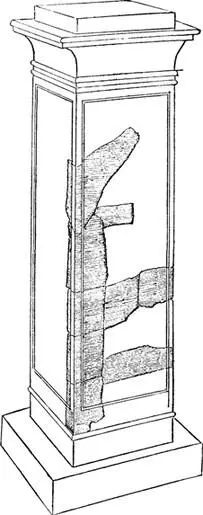Rodolfo Amedeo Lanciani - Pagan and Christian Rome
Здесь есть возможность читать онлайн «Rodolfo Amedeo Lanciani - Pagan and Christian Rome» — ознакомительный отрывок электронной книги совершенно бесплатно, а после прочтения отрывка купить полную версию. В некоторых случаях можно слушать аудио, скачать через торрент в формате fb2 и присутствует краткое содержание. Жанр: foreign_edu, История, История, на английском языке. Описание произведения, (предисловие) а так же отзывы посетителей доступны на портале библиотеки ЛибКат.
- Название:Pagan and Christian Rome
- Автор:
- Жанр:
- Год:неизвестен
- ISBN:нет данных
- Рейтинг книги:3 / 5. Голосов: 1
-
Избранное:Добавить в избранное
- Отзывы:
-
Ваша оценка:
- 60
- 1
- 2
- 3
- 4
- 5
Pagan and Christian Rome: краткое содержание, описание и аннотация
Предлагаем к чтению аннотацию, описание, краткое содержание или предисловие (зависит от того, что написал сам автор книги «Pagan and Christian Rome»). Если вы не нашли необходимую информацию о книге — напишите в комментариях, мы постараемся отыскать её.
Pagan and Christian Rome — читать онлайн ознакомительный отрывок
Ниже представлен текст книги, разбитый по страницам. Система сохранения места последней прочитанной страницы, позволяет с удобством читать онлайн бесплатно книгу «Pagan and Christian Rome», без необходимости каждый раз заново искать на чём Вы остановились. Поставьте закладку, и сможете в любой момент перейти на страницу, на которой закончили чтение.
Интервал:
Закладка:

Pillar commemorating the Ludi Sæculares .
The Ara Ditis et Proserpinæ. On the 20th of September, 1890, the workmen employed in the construction of the main sewer on the left bank of the Tiber, between the Ponte S. Angelo and the church of S. Giovanni dei Fiorentini, found a mediæval wall, built of materials collected at random from the neighboring ruins. Among them were fragments of one or more inscriptions which described the celebrations of the Ludi Sæculares under the Empire. By the end of the day, seventeen pieces had been recovered, seven of which belonged to the records of the games celebrated under Augustus, in the year 17 b. c., the others to those celebrated under Septimius Severus and Caracalla, in the year 204 a. d. Later researches led to the discovery of ninety-six other fragments, making a total of one hundred and thirteen, of which eight are of the time of Augustus, two of the time of Domitian, and the rest date from Severus.
The fragments of the year 17 b. c., fitted together, make a block three metres high, containing one hundred and sixty-eight minutely inscribed lines. This monument, now exhibited in the Baths of Diocletian, was in the form of a square pillar enclosed by a projecting frame, with base and capital of the Tuscan order, and it measured, when entire, four metres in height. I believe that there is no inscription among the thirty thousand collected in volume vi. of the "Corpus" which makes a more profound impression on the mind, or appeals more to the imagination than this official report of a state ceremony which took place over nineteen hundred years ago, and was attended by the most illustrious men of the age.
The origin of the sæcular games seems to be this: In the early days of Rome the northwest section of the Campus Martius, bordering on the Tiber, was conspicuous for traces of volcanic activity. There was a pool here called Tarentum or Terentum, fed by hot sulphur springs, the efficiency of which is attested by the cure of Volesus, the Sabine, and his family, described by Valerius Maximus. Heavy vapors hung over the springs, and tongues of flame were seen issuing from the cracks of the earth. The locality became known by the name of the fiery field ( campus ignifer ), and its relationship with the infernal realms was soon an established fact in folk-lore. An altar to the infernal gods was erected on the borders of the pool, and games were held periodically in honor of Dis and Proserpina, the victims being a black bull and a black cow. Tradition attributed this arrangement of time and ceremony to Volesus himself, who, grateful for the recovery of his three children, offered sacrifices to Dis and Proserpina, spread lectisternia , or reclining couches, for the gods, with tables and viands before them, and celebrated games for three nights, one for each child which had been restored to health. In the republican epoch they were called Ludi Tarentini , from the name of the pool, and were celebrated for the purpose of averting from the state the recurrence of some great calamity by which it had been afflicted. These calamities being contingencies which no man could foresee, it is evident that the celebration of the Ludi Tarentini was in no way connected with definite cycles of time, such as the sæculum .
Not long after Augustus had assumed the supreme power, the Quindecemviri sacris faciundis (a college of priests to whom the direction of these games had been intrusted from time immemorial) announced that it was the will of the gods that the Ludi Sæculares should be performed, and misrepresenting and distorting events and dates, tried to prove that the festival had been held regularly at intervals of 110 years, which was supposed to be the length of a sæculum . The games of which the Quindecemviri made this assertion were the Tarentini, instituted for quite a different purpose, but their suggestion was too pleasing to Augustus and the people to be despised. Setting aside all disputes about chronology and tradition, the celebration was appointed for the summer of the year 17 b. c.
Plan and section of the Altar of Dis and Proserpina.
What was the exact location of the sulphur springs, the Tarentum, and the altar of the infernal gods? I have reason to regard the discovery of the Altar of Dis and Proserpina as the most satisfactory I have made, especially because I made it, if I may so express myself, when away from Rome on a long leave of absence. It took place in the winter of 1886-87, during my visit to America. At that time the work of opening and draining the Corso Vittorio Emanuele had just reached a place which was considered terra incognita by the topographers, and indicated by a blank spot in the archæological maps of the city. I mean the district between the Vallicella (la Chiesa Nuova, the Palazzo Cesarini, etc.) and the banks of the Tiber near S. Giovanni dei Fiorentini. The reports spoke vaguely about the discovery of five or six parallel walls, built of blocks of peperino, of marble steps in the centre of this singular monument, of gates with marble posts and architraves, leading to the spaces between the six parallel walls, and finally, of a column with foliage carved upon its surface. On my return to Rome, in the spring of 1887, every trace of the monument had disappeared under the embankment of the Corso Vittorio Emanuele. I questioned foremen and workmen, I consulted the notebooks of the contractors, every day I visited the excavations which were still in progress, on each side of the Corso, for building the Cavalletti and Bassi palaces, and lastly, I examined the "column with foliage carved upon its surface," which in the mean time had been removed to the courtyard of the Palazzo dei Conservatori on the Capitol. This marble fragment, the only one saved from the excavations, gave me the clue to the mystery. It was not a column, it was a pulvinus , or volute, of a colossal marble altar, worthy of being compared, in size and perfection of work, with the Altar of Peace discovered under the Palazzo Fiano, with that of the Antonines discovered under the Monte Citorio, and with other such monumental structures. There was then no hesitation in determining the nature of the discoveries made in the Corso Vittorio Emanuele; an altar had been found there, and this altar must have been the one sacred to Dis and Proserpina, as no other is mentioned in history in the northwest section of the Campus Martius.
The drawings which illustrate my account of the discovery 45prove that the altar rose from a platform twelve feet square, approached on all sides by three or four marble steps, that platform and altar were enclosed by three lines of wall at an interval of thirty-six feet from one another, and that on the east side of the square ran a euripus , or channel, eleven feet wide, and four feet deep, lined with stone blocks, the incline of which towards the Tiber is about 1:100. This last detail proves that when the rough altar of Volesus Sabinus was succeeded by the later noble structure, the pool was drained, and its feeding springs were led into the euripus , so that the patients seeking a cure for their ailments could bathe in or drink the miracle-working waters with greater ease. No attention whatever was paid to the discovery at the time it took place. Instead of reaching the ancient level, the excavation for the main sewer of the Corso Vittorio Emanuele was stopped at the wrong place, within three feet of the pavement; consequently whatever fragments of the altar, of inscriptions, or of works of art, were lying on the marble floor will lie there forever, as the building of the palaces on either side of the Corso, and the construction of the Corso itself, with its costly sewers, sidewalks, etc., have made further research impossible, at least with our present means.
Читать дальшеИнтервал:
Закладка:
Похожие книги на «Pagan and Christian Rome»
Представляем Вашему вниманию похожие книги на «Pagan and Christian Rome» списком для выбора. Мы отобрали схожую по названию и смыслу литературу в надежде предоставить читателям больше вариантов отыскать новые, интересные, ещё непрочитанные произведения.
Обсуждение, отзывы о книге «Pagan and Christian Rome» и просто собственные мнения читателей. Оставьте ваши комментарии, напишите, что Вы думаете о произведении, его смысле или главных героях. Укажите что конкретно понравилось, а что нет, и почему Вы так считаете.












